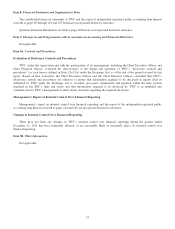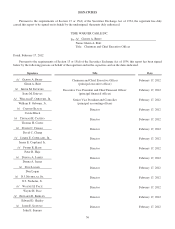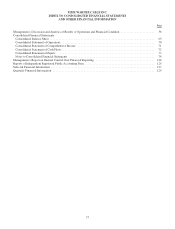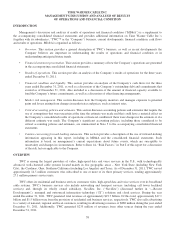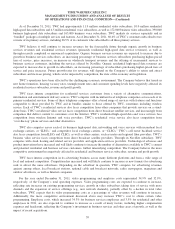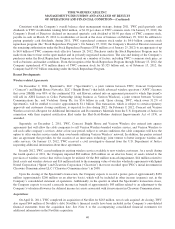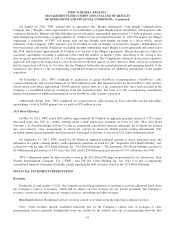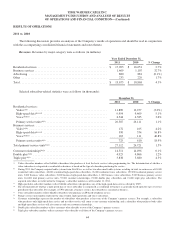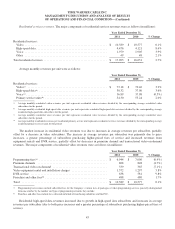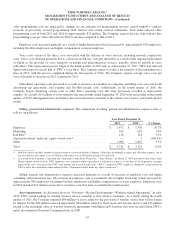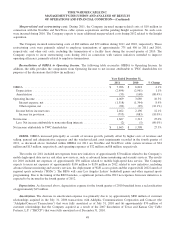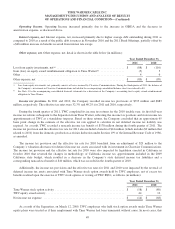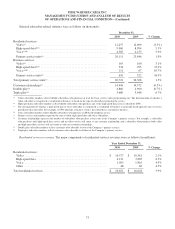Time Warner Cable 2011 Annual Report Download - page 50
Download and view the complete annual report
Please find page 50 of the 2011 Time Warner Cable annual report below. You can navigate through the pages in the report by either clicking on the pages listed below, or by using the keyword search tool below to find specific information within the annual report.TIME WARNER CABLE INC.
MANAGEMENT’S DISCUSSION AND ANALYSIS OF RESULTS
OF OPERATIONS AND FINANCIAL CONDITION—(Continued)
include. Video revenues also include related equipment rental charges, installation charges and fees collected on behalf of
local franchising authorities and the Federal Communications Commission (the “FCC”). Additionally, video revenues
include revenues from premium channels, transactional video-on-demand (e.g., events and movies) and digital video recorder
(“DVR”) service.
High-speed data. High-speed data revenues primarily include residential subscriber fees for the Company’s high-speed
data services and installation charges. The Company offers multiple tiers of high-speed data services providing various
service speeds and other attributes to meet the different needs of its subscribers. In addition, high-speed data revenues
include fees received from third-party Internet service providers (e.g., Earthlink) whose on-line services are provided to some
of TWC’s customers.
Voice. Voice revenues include subscriber fees from residential voice subscribers, along with related installation charges,
as well as fees collected on behalf of governmental authorities.
Other. Other revenues include revenues from home monitoring and security services and other residential subscriber-
related fees.
Business services. Business services revenues consist of revenues from the following business services:
Video. Video revenues include the same fee categories received from business video subscribers as described above
under residential video revenues.
High-speed data. High-speed data revenues primarily include business subscriber fees for the Company’s high-speed
data service and installation charges. High-speed data revenues also include amounts generated by the sale of commercial
networking and point-to-point transport services, such as Metro Ethernet services.
Voice. Voice revenues include subscriber fees from business voice subscribers, along with related installation charges,
as well as fees collected on behalf of governmental authorities.
Wholesale transport. Wholesale transport revenues primarily include amounts generated by the sale of point-to-point
transport services offered to wireless telephone providers (i.e., cell tower backhaul) and competitive carriers.
Other. Other revenues primarily include revenues from managed and outsourced IT solutions and cloud services
provided by NaviSite, revenues from business monitoring and security services and other business subscriber-related fees.
Advertising. Advertising revenues include the fees charged to local, regional and national customers for advertising
placed on the Company’s video and high-speed data services, as well as revenues from advertising inventory sold on behalf
of other video distributors. Currently, most advertising revenues are derived from advertising placed on video services, but
the Company expects a growing percentage of advertising revenues will be derived from non-video sources in the future.
Other. Other revenues primarily include (a) fees paid to TWC (totaling $135 million, $131 million and $127 million in
2011, 2010 and 2009, respectively) by (i) the Advance/Newhouse Partnership and Insight for the ability to distribute TWC’s
Road Runner®high-speed data service and (ii) the Advance/Newhouse Partnership for TWC’s management of certain
functions, including, among others, programming and engineering and (b) commissions earned on the sale of merchandise by
home shopping networks.
Costs and Expenses
Costs of revenues include the following costs directly associated with the delivery of services to subscribers or the
maintenance of the Company’s delivery systems: video programming costs; high-speed data connectivity costs (including
mobile high-speed data service costs); voice network costs; other service-related expenses, including non-administrative
labor; franchise fees; and other related costs.
42



